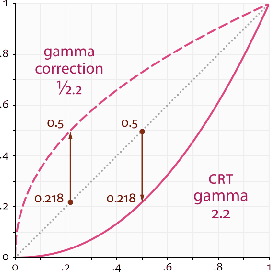
Next: 6.4 Combining Sources of Up: 6.3 Perception of Color Previous: Constancy Contents Index
 |
Displays generally use RGB lights to generate the palette of colors and brightness. Recall Figure 4.36, which showed the subpixel mosaic of individual component colors for some common displays. Usually, the intensity of each R, G, and B value is set by selecting an integer from 0 to ![]() . This is a severe limitation on the number of brightness levels, as stated in Section 5.4. One cannot hope to densely cover all seven orders of magnitude of perceptible light intensity. One way to enhance the amount of contrast over the entire range is to perform gamma correction. In most displays, images are encoded with a gamma of about
. This is a severe limitation on the number of brightness levels, as stated in Section 5.4. One cannot hope to densely cover all seven orders of magnitude of perceptible light intensity. One way to enhance the amount of contrast over the entire range is to perform gamma correction. In most displays, images are encoded with a gamma of about ![]() and decoded with a gamma of
and decoded with a gamma of ![]() .
.
Another issue is that the set of all available colors lies inside of the triangle formed by R, G, and B vertices. This limitation is shown for the case of the sRGB standard in Figure 6.22. Most the CIE is covered, but many colors that humans are capable of perceiving cannot be generated on the display.
Steven M LaValle 2020-01-06